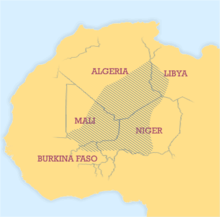Tuareg languages
| Tuareg | |
|---|---|
| Tamasheq, Tamajaq, Tamahaq | |
| Native to | Mali, Niger, Libya, Algeria, Burkina Faso |
| Region | Sahara |
| Ethnicity | Tuareg people |
|
Native speakers
|
(1.2 million cited 1991–1998) |
|
Afro-Asiatic
|
|
| Latin, Tifinagh, Arabic | |
| Official status | |
|
Recognised minority
language in |
|
| Language codes | |
| ISO 639-2 | |
| ISO 639-3 |
Individual codes: thv – Tahaggart Tamahaq taq – Tamasheq ttq – Tawallammat Tamajaq thz – Tayart Tamajeq |
| Glottolog | tuar1240 |
 |
|
Tuareg (English pronunciation: /ˈtwɑːrɛɡ/), also known as Tamasheq (English pronunciation: /ˈtæməʃɛk/), Tamajaq, or Tamahaq, and ⵜⴰⵎⴰⵌⴰⵆ in Tifinagh, is a Berber language, or a family of very closely related languages and dialects, spoken by the Tuareg Berbers, in large parts of Mali, Niger, Algeria, Libya, and Burkina Faso, with a few speakers, the Kinnin, in Chad.
Tuareg dialects belong to the South Berber group, and are commonly regarded as a single language (as for instance by Karl-G. Prasse). They are distinguished mainly by a few sound shifts (notably affecting the pronunciation of original z and h). The Tuareg varieties are unusually conservative in some respects; they retain two short vowels where Northern-Berber languages have one or none, and have a much lower proportion of Arabic loanwords than most Berber languages. The Tuareg languages are traditionally written in the indigenous Tifinagh alphabet. However, the Arabic script is commonly used in some areas (and has been since medieval times), while the Latin script is official in Mali and Niger. In Morocco, of the three official languages (Arabic, French and Berber), Central Atlas Tamazight is the second Berber language. Some scholars claim that Tifinagh-Tamazight is "one of the oldest languages in the world," being close both linguistically and in alphabet to Old Phoenician; that the Phoenician alphabet was progenitor of the Greek, and thereby Western, alphabets.
...
Wikipedia
